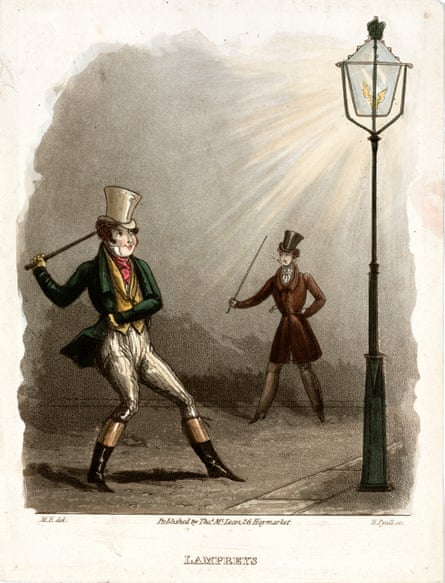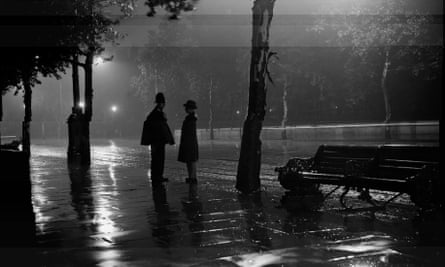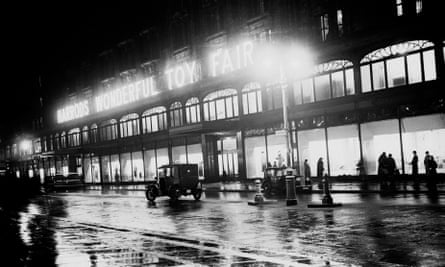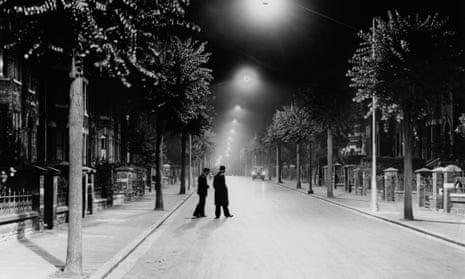On some nights, in the insomniac intervals between rumbling goods trains, and beneath the sound of ambulance sirens, I can hear owls calling mournfully to one another from the trees that screen the railway tracks running past the back of the house in which I live in inner London. On most nights, alongside the shouts of people fighting or having sex, I hear cats and foxes screaming intermittently, as if they are being tortured. On some mornings, when a thin light first leaks through my blinds, I can hear a cockerel croaking from a garden in which chickens are kept a couple of streets away. Occasionally, when the mornings are resonantly still, the insistent tapping of a woodpecker chiselling at a tree trunk wakes me.
The city at night is far eerier, far more feral than it is in the day. It is far harder to anthropomorphise, far more difficult to domesticate. In fact, the city doesn’t necessarily sound and feel like a metropolis, a centre of advanced civilisation, when most of its population is fast asleep. It can sound and feel closer to nature than culture. As Virginia Woolf once pointed out with a noticeable sense of frisson, “we are no longer quite ourselves” after dark. She relished “the irresponsibility which darkness and lamplight bestow”. Our cities, like ourselves, can seem alien and unfamiliar at night. And if you listen to them attentively, as though through an echo sounder, you can hear the encompassing darkness transmit from its depths the noises and pulses of the capital’s pre-modern past.
The sounds I sometimes hear from my bedroom, for example, are identifiably descendants of those that the author and printer William Baldwin enumerated in his eccentric satire Beware the Cat (1553), one of the most evocative records we have of London in the 16th century. At one point, Baldwin’s protagonist, Gregory Streamer, ingests a narcotic and lies in his chamber at Aldersgate listening with preternatural hearing to the “commixed noises” of the nocturnal city. These include the “barking of dogs, grunting of hogs, wailing of cats, rumbling of rats”; the “ringing of bells, counting of coins, mounting of groins, whispering of lovers”; also the “scratching of owls, fluttering of fowls, routing of knaves, snorting of slaves”. He might have added the tapping of cobblers and the shovelling and scraping of “nightmen”, popularly known as “Tom-Turd-Men”, who were employed to clean the city’s streets and privies after dark.
The night-time streams our cities’ pasts. It channels their historical continuities and discontinuities with a clarity and vitality that our everyday lives, which are shaped by an almost uninterrupted purposefulness, constantly obscure. It reminds us that we once shared these cities with innumerable animals, some of them tame, some of them not; and that to some extent we still do. It reminds us that, though we think of the 24-hour city as a comparatively recent phenomenon – if in the UK it is a phenomenon at all – cities have always been hives of labour and leisure after nightfall. Baldwin, in his remarkable onomatopoeic prose poem, refers to the audible nocturnal activities of, among other things, “grouting and spinning, baking and brewing”. It reminds us, too, that we were once fearful of the night, and of the people who inhabit it, whether these assume the form of potential criminals or the police; and that, to a striking extent, especially if we come from socially marginalised groups, we still are.
“However efficiently artificial light annihilates the difference between night and day,” the poet and critic Al Alvarez wrote, “it never wholly eliminates the primitive suspicion that night people are up to no good.” Over the past four or five centuries, a series of social and technological changes have reshaped the city at night, progressively colonising it. The introduction of oil light, gaslight and electric light has, for example, successively reshaped it according to the needs of a diurnal state. And the extension of working hours has reshaped it according to the needs of a daytime economy. But these changes haven’t completely dispelled its pre-modern past. Cities nurture a heart of darkness that even the processes of industrialisation and electrification, the introduction of all-night factories and shops, all-night buses and trains, have failed fully to conquer.

Illustration: SSPL via Getty Images
In 1788, at the height of the Enlightenment, the Daily Universal Register triumphantly reported that “not a single building in all London is perhaps now to be heard of which bears the repute of being an haunted house”. Scientific rationalism, it was optimistically assumed, had rinsed the city’s darker, more mysterious places with the cold, bright light of reason, just as it had driven magic back to the dark ages. But, in the 21st century as in previous ones, London remains, like all cities, a repository of archaic, if not primal, fears and anxieties at night. Anyone who has walked through its empty streets alone at 3am, sensitive to the slightest flicker of movement in the darkness, knows this (not, of course, that these fears and anxieties are necessarily irrational, particularly if you happen to be a woman).
Intellectual enlightenment and the practical illumination of the streets, both enterprises that sought to eradicate remnants of the medieval past, were closely complicit developments in the cities of early modern Europe. Coordinated public street lighting had been in place in central parts of the British capital for a century by the time the newspaper report I’ve quoted complacently declared that its buildings were finally free of ghosts. Paris, operating under the initiative of Louis XIV’s “council for the reform of the policing of the city”, spearheaded the policy in 1667. Other European cities, conscious of the need to pre-empt petty crimes and forestall political conspiracies, followed in rapid succession: Amsterdam in 1669, Turin in 1675, Berlin in 1682, and London in 1684.
Replacing the lantern candles that private householders had formerly been required to erect outside their front doors, most European civic authorities deployed oil lanterns, maintained at public expense, to light the streets on moonless nights. The effect, according to contemporaries, was almost overwhelming. The first report on the “New Lights” of the British metropolis, published in 1690, noted in euphoric tones that they produced “such a mutual reflection, that they all seem to be but one great Solar-Light”.
Public lighting had a decisive impact on Europe’s main thoroughfares, transforming them into places where, at least when the weather was clement, people could promenade and shop after dark. The German novelist Sophie von La Roche, enraptured by London’s culture of consumption, used a letter of 1786 to describe the “double rows of brightly shining lamps” that enabled pedestrians and people in coaches to gaze at Oxford Street’s “splendidly lit shop fronts”.
In some quite literal sense, the city at night in the late 17th and 18th centuries was flamboyant. As the rise of London’s coffee houses and pleasure gardens indicated, “nightlife” became a distinct social phenomenon from this time. It was increasingly fashionable to stay up dancing, drinking, gambling and soliciting prostitutes all night and then remain in bed throughout the next day. This was in part because it dramatised an aristocratic refusal of the protestant ethic and the spirit of capitalism. In populous, upwardly mobile societies like those pioneered in London and Paris, where distinctions of rank could all too easily be obscured in the press of bodies on the streets, the right to roam freely at night was a privilege. And at first light, when revellers staggering home passed labourers walking to work, it was once again unambiguously clear to which social class these individuals belonged.

But if street lighting gentrified and glamorised the commercial and political centres of Europe’s cities in this period, it relegated other regions to no-go areas. The French dramatist Louis-Sébastien Mercier expressed relief in 1780 that thousands of “oil reflectors” had recently replaced lanterns in the French capital. But, as well as protesting that this “excellent innovation” had been “marred by misdirected economy”, he pointedly noted that, outside the shallow pools of dazzling light that the oil lamps emitted, the streets had been plunged into a gloom that seemed deeper and more impenetrable than ever. Certainly, in the poorer areas of Europe’s cities, the new technology made little difference to people’s everyday lives. At night, the serpentine streets, suffocating courts and labyrinthine slums of the city were quite as obscure and noxious as they had been in the middle ages.
The introduction of gaslight in the early 19th century had much the same effect, transforming the areas frequented by the upper and middle classes but leaving those inhabited by the poor pretty much untouched. Even so, alongside the professionalisation of Europe’s police forces, it revolutionised cities at night. In 1807, as part of an energetic campaign to make London the first metropolis to be predominantly lit at night by gas, the expat German entrepreneur Frederick Winsor mounted an exhibition of its benefits in Pall Mall. The Monthly Magazine praised the success of this experiment and the “beautifully white and brilliant” light it produced. By 1823 more than 200 miles of streets in London were lit by almost 40,000 lamps. Light had been industrialised.
Not everyone was happy about this development. Like other Romantics, John Keats complained that the intimate forms of illumination associated with candles and oil lamps, which lit small areas with an uneven, gently flickering flame, and which consequently generated a kind of contemplative aura, were being consigned to the past. An impersonal artificial flare, especially in the regions where the retail dealers “let loose the gas”, was progressively repelling “all the powers of darkness”. Keats lamented the fact that the city’s authorities and commercial interests were exiling night’s magic, its mystery and its majesty, from the city. And his famous Ode to a Nightingale (1819), which celebrates the “embalmed darkness”, was a carefully staged attempt to summon it back.
The illuminating effects of gaslight were far more uniform than those of oil, but electric lighting, which emerged in the 1880s, flooded rather than simply pooled the streets in which it was installed with an intense, apparently white light. Cartoons and paintings from the period proudly depict people standing about on pavements reading newspapers beneath etiolated electric lamps. Electric street lighting became the ultimate badge of metropolitan modernity, and European cities competed with one another to be the pre-eminent City of Light. In the end, New York overtook all of them, including Paris. Meanwhile, cities that retained their medieval topography, and that were slow to introduce the new technology, were consigned to the past. In an article titled “Against Past-Loving Venice” (1910), the Italian Futurist FT Marinetti thundered: “Let the reign of holy Electric Light finally come, to liberate Venice from its venal moonshine…”

But, in spite of the unvarying glare of electric street lights at the commercial, industrial and residential centres, even the 20th century’s most futuristic cities were shaped by socially peripheral, largely working-class areas that remained plunged in darkness at night. The German astronomer Bruno H Bürgel, recalling in 1930 the pride with which his father, who “came from the days of lighting by oil-lamp”, led him through Berlin’s “wealth of light”, drily observed: “A step into the side streets, and you felt set back by centuries.” It was not merely the absence of light, but the presence of the poor at night, and above all the homeless, that made these neighbourhoods seem like remnants of the pre-Enlightenment, pre-capitalist past. The “houseless”, as they used to be called, had been an endemic presence in Europe’s cities after dark since the middle ages, when male and female denizens of the streets were criminalised as “common nightwalkers”.
The 20th-century city nonetheless staged the progressive colonisation of the night by the day, darkness by light. Bars, cinemas, clubs, music halls, theatres and amusement parks catered ever more energetically to people’s appetite for leisure “after hours”. Indeed, the phrase “after hours” seemed more and more meaningless, as factories, hospitals, offices and supermarkets thrummed throughout the night. Even in what had for centuries been called “the dead night”, roughly between 2am and 4am, the centres of major metropolitan cities – places like Piccadilly Circus and Times Square – pulsed with people. “Electric light,” Thomas Edison had insisted, “means night life, and night life means progress.”
In the early 1940s, when the British capital was routinely plunged into darkness during the blitz, Edison’s formula seemed all the more irrefutable. For at that time, conversely, the absence of electric light plunged London, and other European cities, into a state of barbarism. It was perhaps in part because of this traumatic experience that the postwar generation redoubled its commitment to extracting the value of both labour and leisure from the night. The word “clubbing” was first used to mean going to nightclubs in the mid-1960s, when the children of those who been adults through the second world war set about overcoming this inheritance and reclaiming the night.
Since then, as the art historian Jonathan Crary recently wrote in his fine polemic 24/7: Late Capitalism and the Ends of Sleep, the capitalist system has fostered the rise of a society “in which a state of permanent illumination is inseparable from the non-stop operation of global exchange and illumination”. In the late 1990s, to give a spectacular example, a Russian-European space consortium developed plans to use satellites with parabolic reflectors to illuminate remote regions of Earth with sunlight and so enable work to be performed around the clock. Promising “daylight all night long”, it also proposed that entire metropolitan areas might be illuminated after dark along these lines, rendering electric light itself anachronistic. Dreams of the elimination of the night can no longer be dismissed as science fiction.
In the 21st century, electric lighting in advanced capitalist countries – if not in innumerable developing nations – is a uniform and universal feature of cities at night. So is commuting, shopping, working and other activities that for much of the past seemed unimaginable taking place after dark. But in practice, as has been the case for millennia, some people have freer and fuller access to the city at night than others. Lone women may feel excluded from it, for example, if only because at certain times and in certain places they are made to feel unacceptably vulnerable. Black and Asian men, for their part, are far more likely to be criminalised in western cities than white men at night.
The 24-hour tube, it is probably safe to predict, will not fundamentally alter the fact that for many people, if not for the city’s population of cats and feral foxes, London remains, like other British cities, at least partially off limits at night. We have a night-time economy; we need a night-time politics.
Matthew Beaumont is the author of Nightwalking: a Nocturnal History of London, £9.99, Verso. Click here to buy it for £8.19











Comments (…)
Sign in or create your Guardian account to join the discussion